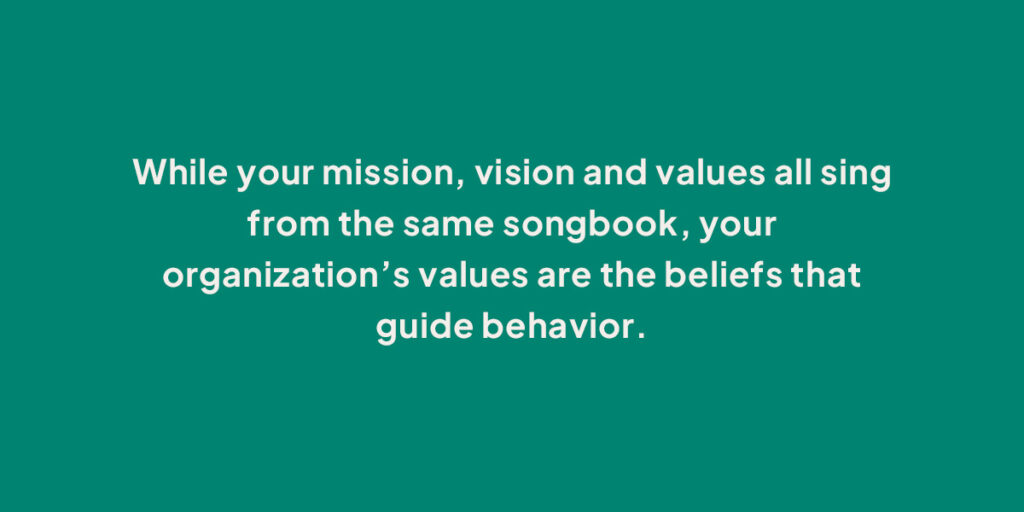Key takeaways
- The star of your employee handbook — Mission, vision and values should be the most compelling part of your employee handbook. Place them in the first few pages and take time to flesh them out. They are NOT only “feel-good” words. They need to have real meaning behind them.
- Employees want a sense of purpose at work – Approximately 70% of employees say their sense of purpose is largely defined by work but only 15% of frontline workers believe they actually live their purpose in day-to-day work, according to McKinsey and Company research.
- Have a mission. And live it. — If you create a mission, vision and values you NEED to live them. If not, they become jokes and create a workforce of disengaged cynics.
Mission. Vision. Values. If you’re employee handbook doesn’t start here, it’s overdue for an overhaul.
But why? Depending on your professional work experience, you may have some strong opinions about corporate missions, visions and values. Perhaps they were hollow words on a company poster at a previous job. Or, maybe your company “said” they lived them but actions said otherwise.
On a more optimistic note, maybe you were lucky enough to work where these important pillars of business were effectively engrained in every decision your company made – from business strategy to hiring new employees.
Regardless of your previous perceptions of corporate missions, visions and values, in today’s workplace they’re more important than ever. That’s because people increasingly need purpose in their work. In fact, 70% of employees in a recent McKinsey and Company study said their sense of purpose is largely defined by work.
The title of that McKenzie study: “Help your employees find purpose or watch them leave.” If that doesn’t drive home the significance of mission, vision and values in today’s workplace, we don’t know what will.
That trend and desire to find purpose in work has only accelerated in the post-COVID world and as younger generations enter the workforce. So, it shouldn’t come as a surprise that your mission, vision and values need to be more than words in a corporate manifesto. You need to live them.
And that’s why they’re the backbone of your employee handbook. They quickly establish what your company stands for, where it’s headed and the beliefs that guide the organization. When done correctly – and clearly communicated to employees – mission, vision and values can bring people together behind a common cause.
But where do you begin? If you have a strong mission, vision and values that your company lives day in and day out. You have a head start. If not, we’re going to help you dial in on what to include. From there, all you need to do is ensure they’re prominent in your employee handbook.

A Mission That Matters
At its core, your mission statement should clearly state why your company exists.
Of course, defining that is easier said than done. Your goal is to create an eternal statement that rarely, if ever, changes. It’s the essence of why you do what you do and should give every person at your organization something to rally behind.
When you start down a path toward creating your company’s mission (we’re assuming in this instance it doesn’t exist), a number of strategies exist to get you to your end goal. While we could get into those, what’s most important to understand is this: Get input from all levels of the company and create alignment.
Start with your executive and leadership team. Dig into why the company exists. Try to go beyond what the company makes. Instead, look at what they solve or want to change in the world. Think big but also be pragmatic.
But don’t stop there. Make sure to listen to employees throughout the organization. Conduct small focus groups or anonymous surveys. The key is to get honest feedback and inputs that the executive team hasn’t influenced.
Then take all that information and distill it. Workshop it with a small group tasked with presenting the final recommendation. Align on it, share it to get buy in, and then live it. We’ve certainly simplified it, but this is the end goal.
To get you inspired, here are a few of our favorite mission statements:
- LEGO: To inspire and develop the builders of tomorrow
- Etsy: To keep human connection at the heart of commerce
- TED: Spread ideas, foster community and create impact
- Google: To organize the world’s information and make it universally accessible and useful
- Ritz Carlton: We are Ladies and Gentlemen serving Ladies and Gentlemen
Your Vision: Showcase what success looks like
Your company’s vision is how it defines success. Seriously, it’s that straightforward.
While it’s predominantly an internal-facing statement, it certainly can influence external communications – from how you interact with customers to your marketing and advertising.
Ultimately, your vision should answer this question: Where are we going as a company?
Your vision should define an achievable goal and it’s usually bound by time. For example, what does your company want to achieve in 10 years and why? This one thing can bring forth a tremendous amount of purpose for employees when done correctly.
To define your vision, take steps similar to what we laid out in the “Mission” section above. Yes, there are tons of tips and tricks available on how to define your vision. But the key is to try and get to a simple statement people can easily understand. Make it inspirational and aspirational and suddenly everyone has a common goal to march toward.

For us, nothing better tells the story than examples, so consider these as you get to work:
- Amazon: Our vision is to be earth’s most customer-centric company, where customers can find and discover anything they might want to buy online.
- Starbucks: To establish Starbucks as the premier purveyor of the finest coffee in the world while maintaining our uncompromising principles while we grow.
- Ben & Jerry’s: Making the best ice cream in the nicest possible way.
- Avon: To be the company that best understands and satisfies the product, service and self-fulfillment needs of women – globally.
- Zappos: To provide the best customer service possible. Deliver ‘WOW’ through service.
Values: Guiding Your Org’s Behavior
While your mission, vision and values all sing from the same songbook, your organization’s values are the beliefs that guide behavior.
In many ways, these are the most human – and most relatable – part of the package. They get at the “how.” How we act. How we work. How we treat our customers.
But, they can also be the hardest for leaders to define out the gate. Not because we don’t all have values – that’s far from the case. Instead, it’s challenging to drill down to a handful of core values that will stand the test of time, remain true to the organization and its people, and ultimately steer business decisions.

Consider these key elements when shaping your values:
- Ensure that every value is something you can live. If your values are going to guide behavior and decision making, they have to be true to the organization and its leadership. If done correctly, your values will attract and retain talent.
- Develop values important and unique to your company. Each value doesn’t have to be unique, but the collection of values should create your own special “recipe” of values. Tell people what’s noteworthy and special about your organization.
- Values should be a clear representation about how your people feel about themselves and their work.
- Values can be lived or aspirational.
- Cultural and operating principles shape your values. A good mix often is best. To make it simple, think of cultural traits as things you have to hire for, while operating principles focus on how the company functions. Cultural traits can’t be taught, while operating principles can.
- Make your values action-oriented with strong verbs. These are the things you do.
- Write them down! That’s probably clear at this point since we’re stressing the significance of putting your mission, vision and values at the forefront of your employee handbook, but hey, a reminder never hurts, right?
Defining a set of core values is an important exercise that should speak to the uniqueness of your organization. But living them is the real challenge. Take these core values, for example: Communication, Respect, Integrity, Excellence. Nice words, but kind of bland, right? They were also the core values for Enron. Putting down nice words is one thing; living them is another.
Of course, many companies seem to get this right and this article wouldn’t be complete without some good examples. Many exist but here’s a few of our favorites:
- Amazon:
- Customer obsession rather than competitor focus
- Passion for invention
- Commitment to operational excellence
- Long-term thinking
- Etsy:
- We commit to our craft
- We minimize waste
- We embrace differences
- We dig deeper
- We lead with optimism
- Trader Joe’s:
- Integrity
- Product-driven company
- Wow customer service
- No bureaucracy
- Kaizen
- The store is the brand
- We’re a national chain of neighborhood grocery stores
If you’re getting started on revamping your current employee handbook or beginning from scratch, consider starting with our free, downloadable template. It’s been vetted by our team of experts and will give you an excellent structure and outline for shaping a high-quality employee handbook that will have real value for your organization.

